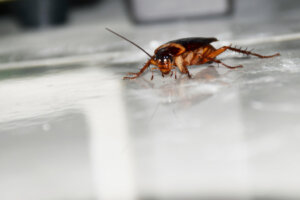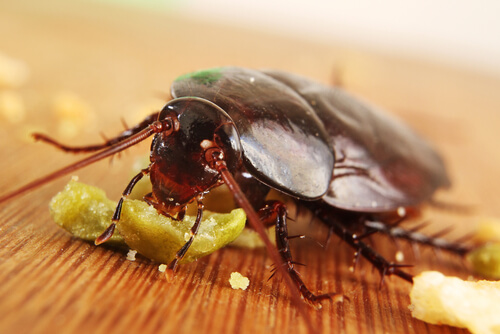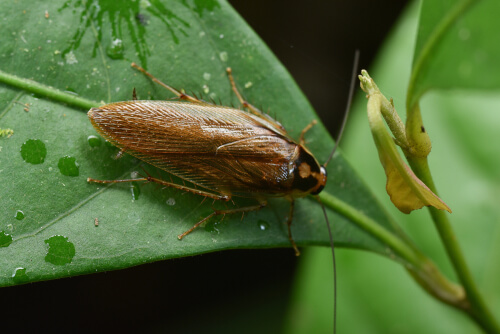5 Curiosities about Cockroach Reproduction


Written and verified by the biologist Georgelin Espinoza Medina
There are many types of insects and creatures that we humans hate, but undoubtedly one of the most repulsive are cockroaches. These insects have an extraordinary way of reproduction and so knowing these curiosities about cockroach reproduction can actually help you fight them.
These animals belong to the Blattodea order, along with termites. They have a flattened body that can hide even in the least expected places. In addition, they’re able to withstand days on end without food and water, which makes them one of the most resistant creatures on the planet.
In this article, we bring you some interesting facts about their reproduction methods. Yes, we know they’re rather gross, but read on and we’re sure you’ll learn some useful information!
Cockroach characteristics

Cockroaches are cosmopolitan and very diverse insects, since there are about 4500 species worldwide. However, about 30 are those that coexist with humans. They vary in size, generally ranging in length from 3 to 7.5 centimeters (1.2 to 3 inches). However, there are some smaller species.
They have a flattened body, with a head, thorax, and abdomen (like other insects). Their colors vary, but most often they’re ocher, brownish or blackish. They have six very agile elongated legs, with which they can run very fast.
They also have a triangular, small, mobile head with chewing mouthparts. They also have compound eyes, long antennae, and most of them have wings.
Curiosities about cockroach reproduction
Although they may seem repugnant and boring, they have striking aspects that relate not only to their lifestyle, but also to the way they mate and multiply. Because of this, take a deep breath, because we’re going to bring you the following curiosities about cockroach reproduction.
1. Males offer a nuptial gift to females
Cockroaches are able to achieve reproduction with a complex and very interesting courtship. Females attract males thanks to the pheromones they produce. When they meet, they make initial contact with their antennae. Then, the males stand in front of the females, raise their wings, and offer a nuptial gift, a secretion from their abdominal glands, composed of sugars and fat, which is very appetizing for the female.
However, this offering has a purpose. It keeps the female busy, while the male establishes contact and mates with her – certainly a very ingenious strategy! This mating can last up to an hour, depending on the species.
2. Cockroaches are changing their tastes regarding their nuptial gift
Some studies have shown that these insects are evolving in terms of their tastes for the male’s nuptial offering. This is thanks to the decades-long use of sugary pesticides to try to eradicate them. Thus, in 1993, German cockroaches (Blattella germanica ) were found to dislike sweets such as glucose.
In addition, research this year published in the journal Communications Biology showed that glucose-averse females are less likely to mate with males that offer these sugary treats. This is simply because they don’t find them too tasty and they don’t distract them for long enough.
These developments are generating an unexpected twist in cockroach reproduction, as they force them to employ certain strategies in order to achieve success. It appears that males are shortening the time required for sperm transfer and also changing the chemistry of the nuptial gift to make it a more palatable substance. However, more studies are needed to tell the definitive outcome of this story.
3. They lay eggs grouped in capsules
Another curiosity about cockroach reproduction is that their eggs are placed in a capsule called an ootheca. This structure can be deposited in a suitable place or is transported for a while by the mother. Each ootheca contains between 6 and 50 eggs, depending on the species.
4. There’s such a thing as cockroach milk
In these insects, there’s great diversity in terms of reproduction. Thus, we don’t only have cockroaches that produce eggs or incubate them internally, but also viviparous specimens, such as the Pacific beetle cockroach (Diploptera punctata), that belongs to the Blaberidae family.
This insect is capable of producing a very nutritious protein secretion to feed its young during incubation, which is known as cockroach milk, something that’s quite extraordinary in this type of animal.
5. Some species of cockroaches can reproduce without males

Despite all the curiosities so far, which make it difficult to stop them from reproducing, these pests have yet another strategic adaptation. In some circumstances, when there’s an absence of males, females can still reproduce, through the divisions of their unfertilized eggs, and the process is called parthenogenesis.
So, these are just a few of our cockroach reproduction curiosities. Undoubtedly, these are interesting aspects that tell us that all organisms, no matter how small and insignificant they may seem, have appropriate strategies to guarantee their success and survival.
There are many types of insects and creatures that we humans hate, but undoubtedly one of the most repulsive are cockroaches. These insects have an extraordinary way of reproduction and so knowing these curiosities about cockroach reproduction can actually help you fight them.
These animals belong to the Blattodea order, along with termites. They have a flattened body that can hide even in the least expected places. In addition, they’re able to withstand days on end without food and water, which makes them one of the most resistant creatures on the planet.
In this article, we bring you some interesting facts about their reproduction methods. Yes, we know they’re rather gross, but read on and we’re sure you’ll learn some useful information!
Cockroach characteristics

Cockroaches are cosmopolitan and very diverse insects, since there are about 4500 species worldwide. However, about 30 are those that coexist with humans. They vary in size, generally ranging in length from 3 to 7.5 centimeters (1.2 to 3 inches). However, there are some smaller species.
They have a flattened body, with a head, thorax, and abdomen (like other insects). Their colors vary, but most often they’re ocher, brownish or blackish. They have six very agile elongated legs, with which they can run very fast.
They also have a triangular, small, mobile head with chewing mouthparts. They also have compound eyes, long antennae, and most of them have wings.
Curiosities about cockroach reproduction
Although they may seem repugnant and boring, they have striking aspects that relate not only to their lifestyle, but also to the way they mate and multiply. Because of this, take a deep breath, because we’re going to bring you the following curiosities about cockroach reproduction.
1. Males offer a nuptial gift to females
Cockroaches are able to achieve reproduction with a complex and very interesting courtship. Females attract males thanks to the pheromones they produce. When they meet, they make initial contact with their antennae. Then, the males stand in front of the females, raise their wings, and offer a nuptial gift, a secretion from their abdominal glands, composed of sugars and fat, which is very appetizing for the female.
However, this offering has a purpose. It keeps the female busy, while the male establishes contact and mates with her – certainly a very ingenious strategy! This mating can last up to an hour, depending on the species.
2. Cockroaches are changing their tastes regarding their nuptial gift
Some studies have shown that these insects are evolving in terms of their tastes for the male’s nuptial offering. This is thanks to the decades-long use of sugary pesticides to try to eradicate them. Thus, in 1993, German cockroaches (Blattella germanica ) were found to dislike sweets such as glucose.
In addition, research this year published in the journal Communications Biology showed that glucose-averse females are less likely to mate with males that offer these sugary treats. This is simply because they don’t find them too tasty and they don’t distract them for long enough.
These developments are generating an unexpected twist in cockroach reproduction, as they force them to employ certain strategies in order to achieve success. It appears that males are shortening the time required for sperm transfer and also changing the chemistry of the nuptial gift to make it a more palatable substance. However, more studies are needed to tell the definitive outcome of this story.
3. They lay eggs grouped in capsules
Another curiosity about cockroach reproduction is that their eggs are placed in a capsule called an ootheca. This structure can be deposited in a suitable place or is transported for a while by the mother. Each ootheca contains between 6 and 50 eggs, depending on the species.
4. There’s such a thing as cockroach milk
In these insects, there’s great diversity in terms of reproduction. Thus, we don’t only have cockroaches that produce eggs or incubate them internally, but also viviparous specimens, such as the Pacific beetle cockroach (Diploptera punctata), that belongs to the Blaberidae family.
This insect is capable of producing a very nutritious protein secretion to feed its young during incubation, which is known as cockroach milk, something that’s quite extraordinary in this type of animal.
5. Some species of cockroaches can reproduce without males

Despite all the curiosities so far, which make it difficult to stop them from reproducing, these pests have yet another strategic adaptation. In some circumstances, when there’s an absence of males, females can still reproduce, through the divisions of their unfertilized eggs, and the process is called parthenogenesis.
So, these are just a few of our cockroach reproduction curiosities. Undoubtedly, these are interesting aspects that tell us that all organisms, no matter how small and insignificant they may seem, have appropriate strategies to guarantee their success and survival.
All cited sources were thoroughly reviewed by our team to ensure their quality, reliability, currency, and validity. The bibliography of this article was considered reliable and of academic or scientific accuracy.
- Grandcolas, P. (1999). El origen de la diversidad de las cucarachas: perspectiva filogenética de su gregarismo, reproducción, comunicación y ecología. Revista IDE@ – SEA, 26, 397-420.
- Pascual, F. (2015). Orden Blattodea. Revista IDE@ – SEA, 48, 1–13.
- Silverman, J., & Bieman, D. (1993). Glucose aversion in the German cockroach, Blattella germanica. Journal of Insect Physiology, 39(11), 925-933.
- Wada-Katsumata, A., Hatano, E., McPherson, S., Silverman, J., & Schal, C. (2022). Rapid evolution of an adaptive taste polymorphism disrupts courtship behavior. Communications Biology, 5(1):450.
- Williford, A., Stay, B., & Bhattacharya, D. (2004). Evolution of a novel function: nutritive milk in the viviparous cockroach, Diploptera punctata. Evolution and Development, (2), 67-77.
This text is provided for informational purposes only and does not replace consultation with a professional. If in doubt, consult your specialist.








